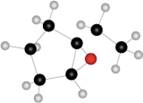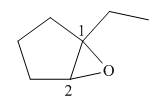
Name each compound depicted in the ball-and-stick models.
a.  b.
b.  c.
c. 
(a)
Interpretation: The name of given compound depicted in the ball-and-stick model is to be stated.
Concept introduction: One should follow the given steps to give the IUPAC name of cyclic alcohol. The first step is naming of ring that contains the carbon bonded to the hydroxyl group. While naming, the -e ending of parent cycloalkane must changed to the suffix -ol. The second step is numbering of carbon chain by providing lowest number to the
Answer to Problem 36P
The name of the given compound depicted in the ball-and-stick model is
Explanation of Solution
The given structure of alcohol is in the form of ball-and-stick model. It is converted into skeletal structure by replacing black ball with

Figure 1
One should follow the given steps to give the IUPAC name of cyclic alcohol. The first step is naming of ring that contains the carbon bonded to the hydroxyl group. While naming, the -e ending of parent cycloalkane must changed to the suffix -ol. The second step is numbering of carbon chain by providing lowest number to the
The above structure of cyclic alcohol shows that it consists of
Thus, the name of the given compound depicted in the ball-and-stick model is
The name of the given compound depicted in the ball-and-stick model is
(b)
Interpretation: The name of given compound depicted in the ball-and-stick model is to be stated.
Concept introduction: One should follow the given steps to give the IUPAC name of ether. The first step is naming of longest chain as an alkane and the shorter chain as an alkoxy group. The second step is applying the other nomenclature rules.
Answer to Problem 36P
The name of the given compound depicted in the ball-and-stick model is
Explanation of Solution
The given structure of ether is in the form of ball-and-stick model. It is converted into skeletal structure by replacing black ball with

Figure 2
One should follow the given steps to give the IUPAC name of ether. The first step is naming of longest chain as an alkane and the shorter chain as an alkoxy group. The second step is applying the other nomenclature rules.
The above structure of ether shows that it consists of
Thus, the name of the given compound depicted in the ball-and-stick model is
The name of the given compound depicted in the ball-and-stick model is
(c)
Interpretation: The name of given compound depicted in the ball-and-stick model is to be stated.
Concept introduction: One should follow the given steps to give the IUPAC name of an epoxyalkane. The first step is naming of alkane chain or ring to which oxygen atom is bonded, and using the epoxy (prefix) to name epoxide. The second step is designating the location of the atoms (using two numbers) to which the oxygen atom is bonded.
Answer to Problem 36P
The name of the given compound depicted in the ball-and-stick model is
Explanation of Solution
The given structure of epoxide is in the form of ball-and-stick model. It is converted into skeletal structure by replacing black ball with

Figure 3
One should follow the given steps to give the IUPAC name of an epoxyalkane. The first step is naming of alkane chain or ring to which oxygen atom is bonded, and using the epoxy (prefix) to name epoxide. The second step is designating the location of the atoms (using two numbers) to which the oxygen atom is bonded.
The above structure of epoxide shows that the cyclopentane ring is bonded to the epoxide ring on

Figure 4
Thus, the name of the given compound depicted in the ball-and-stick model is
The name of the given compound depicted in the ball-and-stick model is
Want to see more full solutions like this?
Chapter 9 Solutions
ORGANIC CHEMISTRY (LL+SM+ACCESS)
Additional Science Textbook Solutions
Chemistry: Atoms First
Chemistry: Structure and Properties (2nd Edition)
Introduction to Chemistry
Chemistry: Structure and Properties
Introductory Chemistry (6th Edition)
Chemistry: A Molecular Approach (4th Edition)
- Which of the following statements about acetone is/are correct?I. Large amount of acetones are produced in the human body.II. Diabetic patients produces larger amounts of acetone.III. In severe diabetes, odor of acetone can be detected on the person's breath.IV. Acetone is partially a by-product in gasoline treatments designed for engine immiscibility to water.arrow_forwardNeed help finding the compound name for each. Thank you!arrow_forwardThe characteristic odor of fish is due to a mixture of alkylamines. Discuss about the alkylamines which are present in seafood.arrow_forward
- 1. WRITE THE IUPAC NAME OF THIS ETHER CH3CH2-O-CH2CH2CH2CH2CH3 2. HOW DO PHENOLS DIFFER FROM ALCOHOLS IN TERMS OF STRUCTURE AND PROPERTIES? 3. HOW DO PHENOLS DEIFFER IN PROPERTIES FROM AROMATIC HYDROCARBONS?arrow_forwardWhich of the following area. hemiacetals? b. acetals? c. hydrates?arrow_forwardExplain the reasons for the following observed properties: (a) Carboxylic acids have higher boiling point than alcohols of similar molecular mass (b) Acetone is soluble in waterarrow_forward
 Chemistry for Today: General, Organic, and Bioche...ChemistryISBN:9781305960060Author:Spencer L. Seager, Michael R. Slabaugh, Maren S. HansenPublisher:Cengage LearningChemistry: Matter and ChangeChemistryISBN:9780078746376Author:Dinah Zike, Laurel Dingrando, Nicholas Hainen, Cheryl WistromPublisher:Glencoe/McGraw-Hill School Pub Co
Chemistry for Today: General, Organic, and Bioche...ChemistryISBN:9781305960060Author:Spencer L. Seager, Michael R. Slabaugh, Maren S. HansenPublisher:Cengage LearningChemistry: Matter and ChangeChemistryISBN:9780078746376Author:Dinah Zike, Laurel Dingrando, Nicholas Hainen, Cheryl WistromPublisher:Glencoe/McGraw-Hill School Pub Co Chemistry: Principles and PracticeChemistryISBN:9780534420123Author:Daniel L. Reger, Scott R. Goode, David W. Ball, Edward MercerPublisher:Cengage Learning
Chemistry: Principles and PracticeChemistryISBN:9780534420123Author:Daniel L. Reger, Scott R. Goode, David W. Ball, Edward MercerPublisher:Cengage Learning



